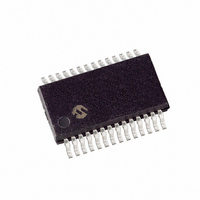PIC16F73T-I/SS Microchip Technology, PIC16F73T-I/SS Datasheet - Page 211

PIC16F73T-I/SS
Manufacturer Part Number
PIC16F73T-I/SS
Description
IC MCU FLASH 4KX14 A/D 28SSOP
Manufacturer
Microchip Technology
Series
PIC® 16Fr
Datasheets
1.PIC16F616T-ISL.pdf
(8 pages)
2.PIC16F688T-ISL.pdf
(688 pages)
3.PIC16F818-ISO.pdf
(6 pages)
4.PIC16F73-ISP.pdf
(174 pages)
5.PIC16F73-ISP.pdf
(14 pages)
6.PIC16F73-ISP.pdf
(12 pages)
Specifications of PIC16F73T-I/SS
Core Size
8-Bit
Program Memory Size
7KB (4K x 14)
Peripherals
Brown-out Detect/Reset, POR, PWM, WDT
Core Processor
PIC
Speed
20MHz
Connectivity
I²C, SPI, UART/USART
Number Of I /o
22
Program Memory Type
FLASH
Ram Size
192 x 8
Voltage - Supply (vcc/vdd)
4 V ~ 5.5 V
Data Converters
A/D 5x8b
Oscillator Type
External
Operating Temperature
-40°C ~ 85°C
Package / Case
28-SSOP
Controller Family/series
PIC16F
No. Of I/o's
22
Ram Memory Size
192Byte
Cpu Speed
20MHz
No. Of Timers
3
Lead Free Status / RoHS Status
Lead free / RoHS Compliant
Eeprom Size
-
Lead Free Status / RoHS Status
Lead free / RoHS Compliant, Lead free / RoHS Compliant
Available stocks
Company
Part Number
Manufacturer
Quantity
Price
Part Number:
PIC16F73T-I/SS
Manufacturer:
MICROCHIP/微芯
Quantity:
20 000
- PIC16F616T-ISL PDF datasheet
- PIC16F688T-ISL PDF datasheet #2
- PIC16F818-ISO PDF datasheet #3
- PIC16F73-ISP PDF datasheet #4
- PIC16F73-ISP PDF datasheet #5
- PIC16F73-ISP PDF datasheet #6
- Current page: 211 of 688
- Download datasheet (3Mb)
14.5.1
14.5.2
1997 Microchip Technology Inc.
PWM Period
PWM Duty Cycle
The PWM period is specified by writing to the PR2 register. The PWM period can be calculated
using the following formula:
PWM frequency (F
When TMR2 is equal to PR2, the following three events occur on the next increment cycle:
• TMR2 is cleared
• The CCPx pin is set (exception: if PWM duty cycle = 0%, the CCPx pin will not be set)
• The PWM duty cycle is latched from CCPRxL into CCPRxH
The PWM duty cycle is specified by writing to the CCPRxL register and to the DCxB1:DCxB0
(CCPxCON<5:4>) bits. Up to 10-bit resolution is available: the CCPRxL contains the eight MSbs
and CCPxCON<5:4> contains the two LSbs. This 10-bit value is represented by DCxB9:DCxB0.
The following equation is used to calculate the PWM duty cycle:
The DCxB9:DCxB0 bits can be written to at any time, but the duty cycle value is not latched into
CCPRxH until after a match between PR2 and TMR2 occurs (which is the end of the current
period). In PWM mode, CCPRxH is a read-only register.
The CCPRxH register and a 2-bit internal latch are used to double buffer the PWM duty cycle.
This double buffering is essential for glitchless PWM operation.
When CCPRxH and 2-bit latch match the value of TMR2 concatenated with the internal 2-bit
Q clock (or two bits of the TMR2 prescaler), the CCPx pin is cleared. This is the end of the duty
cycle.
Maximum PWM resolution (bits) for a given PWM frequency:
Note:
Note:
PWM duty cycle = (DCxB9:DCxB0 bits value) • Tosc • (TMR2 prescale value), in units of time
PWM period = [(PR2) + 1] • 4 • T
The Timer2 postscaler is not used in the determination of the PWM frequency. The
postscaler could be used to have a servo update rate at a different frequency than
the PWM output.
If the PWM duty cycle value is longer than the PWM period, the CCPx pin will not
be cleared. This allows a duty cycle of 100%.
PWM
) is defined as 1 / [PWM period].
OSC
=
• (TMR2 prescale value), specified in units of time
log
log(2)
(
F
F
PWM
OSC
)
Section 14. CCP
bits
DS31014A-page 14-9
14
Related parts for PIC16F73T-I/SS
Image
Part Number
Description
Manufacturer
Datasheet
Request
R

Part Number:
Description:
IC MCU FLASH 4KX14 A/D 28SOIC
Manufacturer:
Microchip Technology
Datasheet:

Part Number:
Description:
IC MCU FLASH 4KX14 A/D 28QFN
Manufacturer:
Microchip Technology
Datasheet:

Part Number:
Description:
IC PIC MCU FLASH 4KX14 28SOIC
Manufacturer:
Microchip Technology

Part Number:
Description:
IC MCU FLASH 4KX14 A/D 28SOIC
Manufacturer:
Microchip Technology
Datasheet:

Part Number:
Description:
IC MCU FLASH 4KX14 A/D 28SSOP
Manufacturer:
Microchip Technology
Datasheet:

Part Number:
Description:
Manufacturer:
Microchip Technology Inc.
Datasheet:

Part Number:
Description:
IC MCU FLASH 4KX14 A/D 28DIP
Manufacturer:
Microchip Technology
Datasheet:

Part Number:
Description:
IC MCU FLASH 4KX14 A/D 28SSOP
Manufacturer:
Microchip Technology
Datasheet:

Part Number:
Description:
IC MCU FLASH 4KX14 A/D 28SOIC
Manufacturer:
Microchip Technology
Datasheet:

Part Number:
Description:
IC MCU FLASH 4KX14 A/D 28SOIC
Manufacturer:
Microchip Technology
Datasheet:

Part Number:
Description:
IC MCU FLASH 4KX14 A/D 28QFN
Manufacturer:
Microchip Technology
Datasheet:

Part Number:
Description:
28 PIN, 7KB STD FLASH, 192 RAM, 22 I/O,
Manufacturer:
Microchip Technology
Datasheet:

Part Number:
Description:
IC PIC MCU FLASH 4KX14 28DIP
Manufacturer:
Microchip Technology

Part Number:
Description:
7 KB Flash, 368 RAM, 25 I/O 28 QFN 6x6mm TUBE
Manufacturer:
Microchip Technology
Datasheet:











